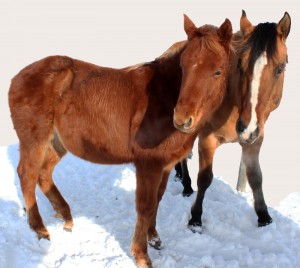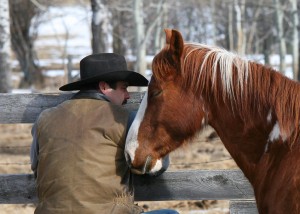How do you handle a nosey horse? It might be simpler than you think.
Several months ago I had a horse-owner friend overnight at my place while on a trip up north. After we had his horse settled, I was giving him a tour of my property and we were walking through the pasture.? As expected, Chip came trotting up to see who the visitor was.

A little background on Chip. He had just turned four. He is playful and very curious; traits I encouraged because they are such an incredible asset: they produce in him try, recognition of success, and comfort in exploring his environment; be that a new trail or a new obstacle on my course. Does he get to do anything he wants?Absolutely not. But there are better ways of showing him that boundary than others.
Anyways, Chip walked right up to my friend, and put his nose near his jacket. I don’t feed any of my horses treats, but my mom has taught him, on her visits, that sometimes pockets can contain goodies. I don’t think that was his motive though. This was a jacket with lots of pockets. Pockets mean zippers and Chip prides himself on being able to open and close a zipper. He has become pretty good at it. It’s totally non-aggressive. If he is asked to stop and back off, he is fine with that. The key word here is ask.
Unfortunately my friend took offense and took the very un-horsemanship-like action of clocking poor Chip in the face with his elbow. Chip was surprised. And rightly so. While my friends motive may have been correct (I don’t want you in my space, his actions were anything but.)
The problem is that we don’t naturally have a handle on space when it comes to a horse. We are too quick to go to our hands before we try anything else. This makes sense to us – as humans we are used to manipulating our environment with our hands. Therefore, we attempt this instinctively with a horse, because we need another method of communication since the horse doesn’t have a full English vocabulary. Horses however, use a different form of communication to ask another horse to move. Thus we have a powerful tool: we can emulate the horses behavior.
Consider only using your hands to support and shape an action, not as a primary method to force your intention.
Compare Chip’s actions to a close talker human. We have all had those people that like to stand in your bubble when they talk to you. I personally do not enjoy that and prefer to be at least two feet from anyone I am talking to. If someone intrudes on my space, I will increase my back off energy and hope that they pick up on that. If they are too tuned out to get that, I will politely say, Do you mind stepping back a bit, please? I say this not to offend the speaker, but to allow us to have a conversation in comfort. And my comfort is important: if I am irritated I won’t be a good conversationalist because I will be distracted.
But what if, instead of asking the speaker to step back, I just hauled off and punched him in the nose the moment he got too close? Would there be anything wrong with that? If you think there is, then you are fairly well acquainted with social norms. If you think that would be all right, as tempting as it sometimes may be – you belong to a social minority and are probably reading this from your prison cell.
Punching the close talker in the nose and clocking my horse in the face are the exact same thing. The horse is further in your space than you feel is appropriate. Or more likely, someone at one point told you that it is bad for horses to do that and the solution is to get physical with them. This is akin to jerking on the lead rope or rein; all these actions simply tell the horse, Hey buddy, I am just confirming that I am inconsiderate and not interested in communicating with you. Perhaps you have never given a thought to learning how to communicate with the horse in his language. Space is one of the most basic equine communication elements.
So what to do about it? Look at it from the close talker example. What I won’t do is back away. This will just invite the close talker in, back to where he was. And by doing so, I have let him know that it’s OK to be there. I have submitted to him. Now we are playing a game. This is not desirable. With a horse, particularly one like Chip, it’s dangerous road to go down, because now he knows that HE can move YOU. Effectively you have given the horse the reins and you’re wearing the bridle.

This is a Kodak Moment. You know all those times you wished a camera was there? Well this time, there was. A friend was taking pictures of Spud when I first got him. This intimate shot captures the moment when Spud decided that we were going to have a positive relationship. Previously he did not want anything to do with me, or any other human for that matter. Spud is clearly, and voluntarily in my space. The decision to be there was his alone. What did I do about it? Well, I totally relaxed and enjoyed every second of it. His reward for his decision to include me in his life was to enjoy peace and contentment in my space.
Let’s look at this in terms of pressure. We are all familiar with pressure and release when it comes to working with a horse. What you might not have considered is that there are many types of pressure, and many levels of pressure intensity. Consider pressure on a scale from 1 to 10. A 1 in pressure would be increasing my energy to show the close talker or horse that they are in my space. If that doesn’t work, I won’t continue to repeat it, but change the type of pressure to something more obvious, like politely asking the close talker to take a step back. With a horse this could be stepping forward into his space with more energy. More pressure does not mean that you should get angry or be forceful.
Remember, you are striving to be a calm and effective leader.
If there is still no response from the horse after this then you are now having a conversation about leadership via space. And you need to clean it up properly. Going from a 1 to a 10 on the pressure scale and hitting the horse or close talker is unreasonable at this point. I would do this in a case where the horse ran in and tried to bite me with malice, or if the close talker ran at me wielding a knife. If you feel your life is being threatened, then sure, do anything you have to in order to save your own hide. But simply stepping in my space? An offensive physical move like hitting is totally uncalled for in this situation and not the mark of a horseman.
Instead, take this approach. Just like asking the close talker to step back, put your hand on the horses nose. Apply firm pressure, but don’t push, because then you are just inviting a challenge, and the horse pushes back with the same or more force. Simply make it clear that there is an invisible wall there.
Now, just wait.
Waiting is hard for people–but learn to wait, you will go way further when working with a horse if you give him the opportunity to be right and wait on it.

The horse may push against you. He may move his nose to a different position in order to continue with his original mindset. Keep your hand in the same spot on his nose, with the same amount of pressure, as long as he is still on your invisible wall. The horse may push against you; but you do not push back. These might feel like the same thing but there is a huge difference in meaning. Eventually, the horse will take a step back. It is totally expected that initially he might repeat the same challenge two or even three times. Chip is a horse like this. If he moves in again after he has correctly yielded to my pressure, then I will repeat the same exercise because now we are successfully training with repetition. I don’t step up the pressure because he got it right: he yielded to my space. After the third time a really cool thing happens. Chip stands back and puts his head down and relaxes. Or maybe walks away contentedly.
Why does he respond this way? He does because I have answered a question for him: Whose space is this, mine or yours? And when I calmly provide that answer, he is no longer bothered by the question. Space and herd order is a huge deal for a horse. Lack of clarity in that area will bother him. Once you provide that clarity your horse will find peace, having answered the question and taken that stress off his plate. It’s simply how their minds work.
So why not hit him? Won’t that say the same thing ? Absolutely not. Consider the response of the close talker if I were to hit him. He would most likely be shocked and then would respond with one of two actions: 1) Take a swing at me, ready for an all out fight or 2) Leave, thinking I was a complete jerk.
The horse will do similar things in response to being hit. Either come into your space with more force, because now you have made it obvious that this is a challenge; or he will shake his head or even kick out as he is trotting away. In this case, Chip took it as a challenge. He didn’t back away but instead put his head way up in the air, out of reach, and stepped back in. Now we had a real issue. Instead of clearing up the space question, it escalated into a challenge/leadership issue. Not wanting the situation to get bigger, I stepped in and had Chip stand on the other side of me. Chip and I have a defined understanding about our spatial relationship.
I want any horse I work with to be comfortable and clear with our spatial and leadership agreement. I don’t want him to fear being around me, or anyone else, for that matter. I want to make the space around me a good and peaceful place for him to be, but with a respectful boundary.
This is absolutely essential because when you ride, you and your horse are intimately within each others space.
Scott Phillips
October 2014
